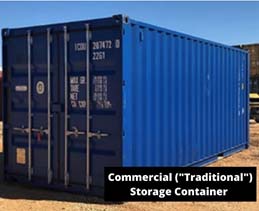Reported in RestaurantNews.com
October 29, 2021Why are the “Residential” and “Commercial” Storage Industries Considered Separate?

Historically, the “residential” and “commercial” storage industries have been considered separate industries for several reasons.
First of all, their target market is believed to be different. “Traditional” shipping containers are associated with the commercial market. On the other hand, “portable” storage containers have been used for residential and moving purposes.

Secondly, “residential” and “commercial” container professionals see their respective products as considerably different. The “traditional” shipping container – also known as an “inter-modal freight container” or an “ocean container” – is meant for “heavier duty” purposes. These containers are large (usually 20 or 40 ft. wide x 8 ft. tall), corrugated, wind-and-water-tight steel boxes, and designed for international trade. Then, they are typically reused as commercial storage units. These containers have been used and recycled for about 80+ years. There are about 20 million of them currently in circulation.
The portable storage and moving container industry (sometimes referred to as “mobile self-storage”) is only about 20 years old. These containers are also reusable, wind-and-water-tight, and made of primarily steel, with some composite and wood options available.
However, it’s important to note the similarities between the two products. Their interiors are often different (one is thicker, heavier-duty steel and one is lighter-duty steel with composite and wood options). However, they are both wind-and-water-tight units that can be transported in similar ways. Additionally, they solve similar “storage” challenges in ways that closely align with one another. More on that soon.
Why the “Residential” and “Commercial” Industries are Merging
As the portable storage industry matures and enters its second decade, it’s beginning to converge with the commercial storage industry. Why is this happening? Well, as Rod Bolls of Boxwell puts it, part of the reason for this is that –
“These industries have more in common than one might imagine. Currently they are headed down a path of convergence with the eventual meeting place in the very near future vis-a-vis the portable storage container as a ubiquitous term and product.”
Rod Bolls, Boxwell Co.
Converging Buyer Needs
In the past, commercial storage suppliers have tended to work independently of residential storage and long-distance moving markets. However, consumer needs are beginning to change that trend. The industries essentially share the same purposes and offer solutions to very similar interests.
Both commercial containers and the residential/moving containers offer convenient and portable space for storage purposes. When people are looking for a storage solution, they are often looking for a quick, seamless solution. Both industries are focused on offering this. Buyers often don’t distinguish between suppliers based on product or market type before they start looking. Meaning, they are not looking specifically to be accommodated by a “commercial dealer” vs. a “residential dealer”. In fact, many storage container buyers are looking to the supplier for advice about particular units, shipping and delivery options, pricing, and more.
In January 2020, 360Connect conducted a research survey that received 535 responses from actively-looking storage container buyers. The results supported this same idea. Prospects don’t care whether their product is meant for “lighter-duty” (more residential or light commercial applications) or for “heavier duty” (more commercial or industrial applications). They simply want a fast, easy, and seamless storage solution.

Only 13.6% of the survey respondents said they were sure they preferred a commercial (“traditional”) storage container. The rest either didn’t have a preference, or were looking for supplier advice.
Economic Influences
Rod Bolls of Boxwell also notes that there are economic reasons for the portable/moving storage industry converging with traditional storage industries.
First of all, the market for portable storage containers is rapidly increasing. In the past, Americans typically had two ways to handle a residential move. They either paid a full-service moving company or van line for help, or did it themselves. Nowadays, home-owners and apartment-dwellers have a less expensive, more personalized way to move their belongings to a new space. This opens up the portable storage container as a convenient option to some 31 million Americans who move each year. On top of that, some 3 million Americans now move across the country each year – many of which won’t be able to afford a full-service move of that distance.
Monthly Revenue for Rentals
Most storage container dealers make a good chunk of their revenue off renting out their containers for a given period of time. Compared to commercial storage containers, renting out portable storage containers carries the potential to generate more monthly revenue.
Why is this? Well, people simply pay more money to rent a portable storage container. They also are required to pay a drop-off/delivery fee and a pick-up fee. Commercial storage container rentals are more inexpensive for customers, by hundreds of dollars monthly. Now, commercial storage containers tend to have longer rental periods. They usually sit at a commercial site longer than a moving container does at a residential site. However, dealers who rent out portable storage containers have the opportunity to rent their container out 2-3 times per month. This could generate them $1,000’s more than a commercial container would, which sits at a job site collecting the same, stagnant monthly premium.
In sum, the residential and moving markets are beginning to dominate the storage industry. As of 2019, these markets made up 55.4% of the industry’s revenue. This number is anticipated to keep growing quickly, with 1 in 10 Americans needing a residential storage solution every year. People are accumulating stuff, for lack of a better word. They are starting to rely on the portable storage and moving industry as a solution. It’s becoming a segment of the storage container market that commercial suppliers can no longer overlook as a key source of income.
Why Commercial Suppliers Should Adapt Portable Storage and Moving Inventory
As mentioned, portable/moving storage is taking larger market share of the industry year over year. It’s looking like a smart option for commercial storage container dealers to leverage this trend and add portable storage and moving containers to their inventory. Doing so would give container companies the following advantages:
Higher Conversion Rates
As mentioned, the storage container markets are already expanding and overlapping on their own. Naturally, traffic to storage container companies is starting to consist of both types of buyers – commercial and residential. Because suppliers who offer portable storage solutions solve similar challenges for buyers, commercial suppliers are likely receiving tons of leads they can’t utilize. These leads are either indifferent or looking for advice on which container to buy. This means, if you’re a dealer who is not currently offering easy add-ons to your inventory – like portable storage, moving, and other storage options – you’re turning easy conversions away.
Remember that residential and moving markets are responsible for over half of the storage industry’s revenue. These markets offer lucrative opportunities for container suppliers – and a serious chance to boost their R.O.I.
The “Do It Yourself” Factor
Rod Bolls of Boxwell cites “Do-It-Yourself” (DIY) as one of the convenience factors that’s drawing the two industries closer together. Both commercial and residential dealers are currently leveraging the convenience of the “do it yourself” option. People are starting to want to handle storage – no matter the purpose – on their own. At the same time, they want the seamless option of easy delivery and installation that both types of dealers offer. If the industries were to merge and companies were to offer both options, they would be able to offer a cohesive, unified portable storage solution to a variety of markets.
Similarity in Product Types
According to Bolls and other industry experts, it’s a misconception that the portable/moving container and traditional/ocean container are entirely different products. Actually, both types of containers share a good number of similarities. They are both waterproof, wind resistant, stackable, secure, quickly assembled, lightweight, and more. Additionally, many portable/moving containers can be knocked-down to allow reduced transportation costs, quick-assembled, and light-weight to reduce damage to driveways and residential features.
Other advantages of portable/moving containers are they can be pre-equipped to be mobilized the same way as a commercial container would be. They include internal tie-downs, signage, optional wheels, and tie-down points to flatbeds or rollback trucks. They can essentially be transported the same way – or alongside – commercial shipping containers (ie. via a rollback truck or any other delivery system.) Commercial dealers would need to make very few changes to their current operations to adapt portable storage and moving containers to their inventory.
As storage container industry professionals and advocates for many years, both 360Connect and Boxwell are excited to see these changes unfold over the next several years. We’re hoping they offer many new opportunities for container professionals to increase their sales and revenue, and grow their businesses.
If you’re looking to (or curious about) adding any portable storage inventory, we highly recommend Boxwell as a reliable dealer that can help you expand your offerings. Also, check out this guide to selling more shipping containers.
If you’re looking for true intent prospects actively looking for storage containers right now – 360Connect can help your business by sending them your way. We give you the opportunity to focus on business operations and sales, while we find and qualify prospects for you. It’s a win-win.

